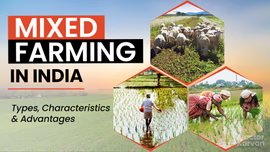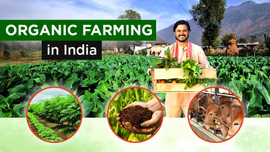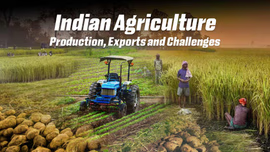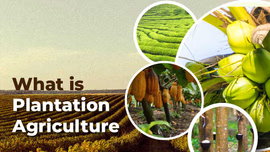Cultivating Self-Sufficiency with Subsistence Farming in India

Subsistence farming involves growing crops for self-consumption, where enough surplus is not left to be sold in the market. In India, this farming method has been in practice for ages and is still largely performed by small and marginal farmers. Read on to learn about subsistence farming practice, its characteristics, types, advantages, and how it is different from commercial farming.
Table of Contents
- What is Subsistence Farming?
- How is Subsistence Farming Practiced in India?
- What are the Characteristics of Subsistence Farming?
- What are the Types of Subsistence Farming?
- What are the Advantages of Subsistence Farming in India?
- What are the Disadvantages of Subsistence Farming in India?
- What is the Difference Between Subsistence and Commercial Farming?
What is Subsistence Farming?
Subsistence farming is a type of farming in which all the crops grown or livestock raised are used for self-consumption by the farmers and their family, leaving very little, if any, surplus for selling or trading purposes. It was traditionally practiced by preindustrial agricultural people worldwide. This farming method is practiced in less developed or developing countries, specially in tropical regions. One common feature of subsistence farming is its scattered distribution; small patches of tilled land are surrounded and divided by broad stretches of forest.
How is Subsistence Farming Practiced in India?
Farmers involved in subsistence farming typically do not use advanced tools and machinery, instead relying on traditional methods and techniques.
- Traditional tools and farm implements are used for land preparation and crop harvesting.
- Farmers cultivated various types of crops to achieve self-sufficiency, including wheat, pulses, maize, rice, and cereals.
- Most family members participate in subsistence farming.
- Natural resources are primarily used for irrigation, including rainfall and local reservoirs like ponds.
What are the Characteristics of Subsistence Farming?
Subsistence farming has many unique characteristics that make it different from other farming methods, such as diversified farming, small landholdings, adopting intensive farming techniques, low-input agriculture, limited use of modern methods, labour intensive, and livestock rearing. Let’s discuss them in brief:
Diversified Farming: Subsistence farmers grow a variety of crops, including fruits, cash crops and vegetables. These farmers also prefer staple crops like rice, wheat, and maize.
Small Landholdings: It is performed on small and scattered landholdings. Landholdings are typically less than 2 acres. Thus, subsistence farming is typically conducted on small plots of land, usually under 2 hectares.
Adopting Intensive Farming Techniques: Farmers usually adopt intensive farming techniques that enable small areas can provide maximum yield.
Low-input Agriculture: Farmers depend on traditional farming techniques that involve using low-cost inputs, such as animal & organic manure and agricultural tools like hoes & sickles.
Limited Use of Modern Methods: This farming method employs a limited use of modern methods, including high-yield seed varieties, chemical fertilizers, and tractors. Thus, productivity is also low.
Labour Intensive: Most of the work is done manually, which is also time-consuming. Family members are the common workers in the field.
Livestock Rearing: Farmers are hugely dependent on livestock for most tasks on and off the field. They not only plough the fields but also act as a transportation medium. Also, their manure is a rich source of nutrients for the soil.
What are the Types of Subsistence Farming in India?
Subsistence farming can be practiced using different methods based on local conditions and resources. The popular subsistence farming types in India are primitive subsistence farming and intensive subsistence farming. Let’s discuss them in detail:
Primitive Subsistence Farming
Primitive subsistence agriculture involves the cultivation of small patches of land. Family members or community labourers are employed to grow crops using non-modern tools, such as dao and digging sticks. Several environmental factors, including natural soil fertility and monsoons, influence this farming method.
Primitive subsistence farming is further classified into shifting cultivation and nomadic herding.
Shifting cultivation, also known as 'slash and burn' farming, involves first clearing the land by cutting and burning trees, and then mixing the ashes with the soil. Crops like potatoes, cassava and maize are grown. As the soil becomes infertile over time, farmers move to a new patch of land for cultivation. In north-eastern states like Nagaland, Meghalaya and Assam, this method is also known as jhumming.
Nomadic herding is another type of primitive subsistence farming method. Farmers raise livestock, such as goats, sheep, and cattle, and move them from place to place to find water and pasture. These animals provide several products, including hides, wool, meat, and milk, to the herders.
Intensive Subsistence Farming
In this method of farming, farmers grow crops on small land with the help of more labour and simple tools. It is typically practised in regions with intense pressure on land due to high population densities. Irrigation and more biochemical inputs are used to obtain higher yields.
The main crop grown using this method is rice, while other examples include oilseeds, pulses, maize, and wheat. Farmers can grow more than one type of crop in a year if there is fertile soil and a sunny climate. They lack alternative livelihood sources, so they exploit the limited land to maximize output.
What are the Advantages of Subsistence Farming?
Subsistence farming is still widely practised, even though farmers are increasingly adopting commercial agriculture on a large scale. The advantages of subsistence farming in India are:
- Farmers are mostly dependent on organic manure to help maintain soil fertility. Using organic manure is a vital component of sustainable agriculture.
- This farming method is inexpensive as it does not demand high-cost inputs or modern machinery. Thus, it becomes a viable option for small farmers with limited resources.
- Food security is ensured by subsistence farming for small farmers and their families. They get fresh food throughout the year.
- Self-sufficiency is promoted by this farming method as it allows farmers to meet their own food needs. It reduces risks associated with market fluctuations and offers greater control over crop production.
- The foundation of subsistence farming is rooted in traditional knowledge and practices. Using these practices and knowledge from different generations helps preserve the region's culture.
What are the Disadvantages of Subsistence Farming in India?
While subsistence agriculture has some advantages, it also has certain disadvantages, such as:
- Loss of soil fertility and land degradation.
- Lack of access to resources and markets.
- Low productivity is often attributed to traditional farming practices.
- Lack of surplus limits the income of farmers.
- Limited scope for crop diversification.
What is the Difference Between Subsistence and Commercial Farming?
|
Subsistence Farming |
Commercial Farming |
|
Focuses on fulfilling the needs of the farmer and his family for survival or self-sufficiency by raising crops and livestock. |
Focuses on raising crops or livestock mainly for trading them to make money and fulfil market demands. |
|
The use of labour-intensive and traditional methods is prominent due to the minimal funds and area required. |
Modern technology and farm machinery are used due to large demand and area. |
|
There is a reduced reliance on farming inputs, such as fertilizers and pesticides. |
Pesticides, fertilizers, genetically modified organisms, and other agricultural inputs are used intensively to achieve higher productivity and yields. |
|
The crop selection is less specialized. |
Crop and livestock selection is highly specialized, primarily for marketability purposes. |
|
There is a low reliance on markets and infrastructure, as they are less affected by factors such as global trade and economic fluctuations. |
They are very closely linked to market demands and transportation systems, as they are vulnerable to market trends and other economic factors. |
Although subsistence farming offers many ecological benefits, attention must also be paid to its drawbacks. Promoting modern farming practices and access to credit, as well as market opportunities, is crucial to improve subsistence farming. These steps will go a long way to improve the productivity and income of small farmers.
Frequently Asked Questions On Subsistence Farming
1. What is subsistence farming?
Subsistence farming involves growing crops and rearing animals only for personal use.
2. What is intensive subsistence farming?
In intensive subsistence farming, farmers grow crops on a small plot of land using more labour and simple tools.
3. What is primitive subsistence farming?
In primitive subsistence farming, small patches of land are cultivated by family members or community labour using non-modern tools like dao and digging sticks.
4. What is another name for primitive subsistence farming?
The other name for primitive subsistence farming is shifting or slash-and-burn cultivation.
5. What is the difference between subsistence farming and commercial farming?
Subsistence farming produces food on small-scale farms that farmers and their members consume. Commercial farming is the large-scale cultivation of crops that are sold in the market for profit.
6. Why do farmers use traditional tools in subsistence farming?
Farmers use traditional tools in subsistence farming as they cannot afford modern tools. Additionally, modern tools are not preferred due to the limited land area.
7. What makes subsistence farming flourish in India?
Subsistence farming flourishes in India because there is a lack of alternative livelihood sources and the presence of small landholdings.
8. Where is intensive subsistence farming practiced in India?
Intensive subsistence farming is practiced in India in states like Kerala, West Bengal and Tamil Nadu.
9. Why is subsistence farming important?
Subsistence farming is important because of its advantages, such as food security, self-sufficiency, and low input costs.
10. What are the characteristics of primitive subsistence farming?
The characteristics of primitive subsistence farming include small landholdings, low productivity, and the use of traditional tools and techniques.


Related Blogs












